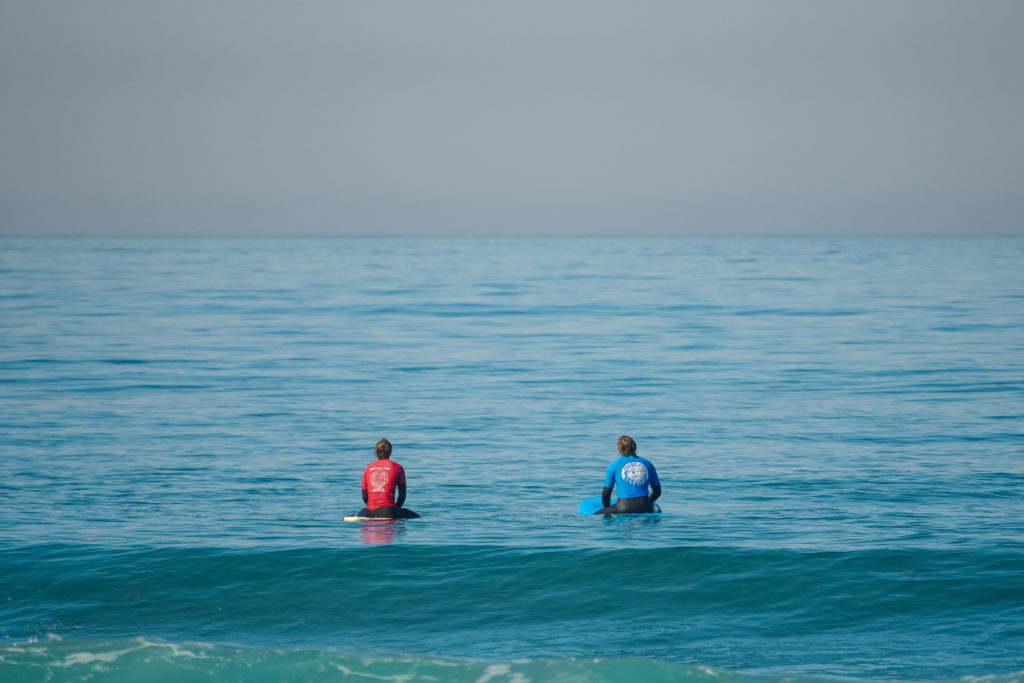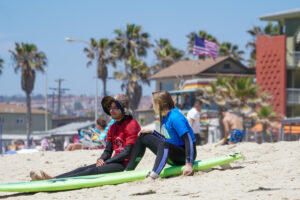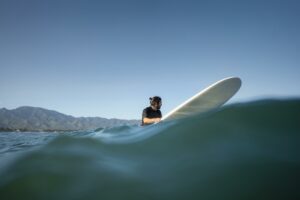Learning How To Surf – How Long Does It Take?
Surfing is a sport that has attracted people from all over the world, with its combination of thrill and beauty. It is a sport that is not only physically challenging but also requires a great deal of patience and perseverance to master. One question that many people ask before embarking on this journey is, “how long does it take to learn to surf?”
While there is no simple answer to this question, as it depends on many factors, this article will discuss various factors that impact the learning process, the stages of skill development in surfing, and learning strategies that can speed up the process.
Equipment Needed for Learning How to Surf
Learning how to surf requires more than just a board and determination. The right equipment will help you stay safe and have the best experience possible.
To begin, you’ll need a quality surfboard that is the correct size for your body type and skill level. Beginners should look for boards with thicker foam cores and wider tails, which provide stability in the water.
A good wetsuit is also essential as it will keep you warm even when the ocean temperatures are cold. If you plan to surf in warmer waters, a rashguard or swim shirt can provide protection against sunburns and jellyfish stings.
Finally, fins are an important part of surfing as they help provide control while riding waves. Make sure to choose fins that match your board size and weight so you can maximize performance in the water.
With all of these items on hand, you’ll be able to hit the waves safely and confidently!
Factors That Affect How Long It Takes to Surf
Learning to surf can be a unique experience for everyone, with many different factors impacting how long it takes to become proficient. Here are some factors that can affect surfing learning time:
- Age: Younger individuals tend to learn faster than older learners, as they have greater flexibility and may have fewer fears and inhibitions about trying new things.
- Fitness level: Surfing requires a lot of physical stamina and strength. Being in good physical shape can help learners avoid fatigue and injury, allowing them to practice and improve more frequently.
- Prior experience: Having prior experience with board sports like skateboarding or snowboarding can give learners a head start in understanding the basic mechanics of balance and movement on a board.
- Access to quality instruction: Access to proper instruction is crucial in developing proper techniques, form, and safety procedures. With the right instruction, learners can progress more quickly and avoid developing bad habits or dangerous habits.
It’s important to keep in mind that every individual’s experience is different, and the factors that impact learning time can vary. By focusing on building a strong foundation in the basics, seeking quality instruction, and practicing regularly, anyone can learn to surf at their own pace and enjoy the process.
The Stages of Surfing Skill Development
The stages of surfing skill development are generally broken down into three categories: beginner, intermediate, and advanced. The beginner stage is where learners first start to get comfortable in the water and learn the basic techniques of paddling and popping up on the board. At the intermediate stage, learners begin to master more advanced techniques, such as turning and trimming on the wave. The advanced stage is where learners refine their skills and start to develop their own style and approach to surfing.
Beginner surfers should focus on the fundamentals such as wave selection, basic board control, and etiquette. As they progress they can begin to learn how to turn and maneuver their board in order to keep up with faster waves. Intermediate surfers should start to focus on developing stronger paddle strokes, refining their turns, and learning more complicated maneuvers like cutbacks and floaters. Finally, advanced surfers can work on perfecting their techniques by practicing high-level maneuvers such as aerials or carving off the lip of a wave.
To progress efficiently through each stage, learners should focus on building a strong foundation in the basics and seek out quality instruction to help them refine their skills. Regular practice is also essential, as surfing is a skill that requires a lot of repetition to master. No matter what stage you’re at in your surfing journey, it’s important to remember that practice makes perfect!
Learning Strategies That Can Speed Up the Learning Process
If you’re interested in learning how to surf, there are several strategies you can employ to speed up your progress and become a skilled surfer in no time. Here are some tips to consider:
Practice regularly: One of the most important strategies for learning to surf is to practice regularly. By creating a routine of regular surfing sessions, you’ll be able to build your skills and gain experience more quickly. This will help you develop muscle memory and improve your balance on the board.
Seek expert advice: It’s also important to seek out advice from experienced surfers and instructors. They can provide valuable feedback on your technique and help you make adjustments that will improve your skills more quickly. In addition, they can offer insights into the local surfing conditions and help you find the best spots to practice.
Watch videos of experienced surfers: Watching videos of experienced surfers can also be a helpful strategy for beginners. By studying their techniques, you can gain a better understanding of the basics of surfing, such as how to paddle, catch a wave, and stand up on the board. You can also learn about different surfing styles and maneuvers, such as carving and cutting back.
Set realistic goals: Finally, setting realistic goals for yourself is an effective strategy for staying motivated in the learning process. For example, you might aim to catch a certain number of waves during each session or to master a specific surfing maneuver. By setting achievable goals and tracking your progress, you’ll be able to see how far you’ve come and stay motivated to continue improving.
By following these strategies, you can accelerate your progress in learning to surf and become a confident, skilled surfer in no time.
Learning How to Surf with Pacific Surf
Do you dream of riding the waves with only your board and nature’s power beneath you? Imagine the feeling of accomplishment as you glide along the swell with no one else in sight. Surfing is a thrilling experience, so it’s no wonder many people want to learn how to do it. Stop asking “how long does it take to learn how to surf?” and come join us here at Pacific Surf School for a surf lesson! Here, you will learn how to surf in no time with help from our professional instructors.
Pacific Surf School offers top-notch surfing lessons for people of all skill levels in some of the best surf spots in California. Whether you are in San Diego, La Jolla, Pacific Beach, Mission Beach, Los Angeles, Ocean Beach, Santa Monica, Santa Cruz, or Huntington Beach, Pacific Surf School is the place to go for an unforgettable surfing experience on the Pacific coast.
With our private, semi-private, and group surf lessons, as well as surf camps, we cater to individual needs and preferences to ensure that everyone gets the most out of their time with us. Our experienced and knowledgeable instructors are passionate about surfing and committed to helping you become a better surfer.
Don’t miss out on the opportunity to catch some waves with Pacific Surf School – contact us today to sign up for a surf lesson!
FAQs
Learning to surf can be challenging, but it is not impossible. Surfing requires a combination of physical skills, such as balance, strength, and coordination, as well as mental skills, such as focus, patience, and determination.
The learning process also involves becoming familiar with the ocean and understanding how to read and navigate waves. However, with proper instruction and practice, anyone can learn to surf.
It is important to have realistic expectations, as progress may be slow at first, but with persistence, you can become a competent surfer.
Surfing without lessons is not recommended for beginners. While it is possible to learn on your own, it is much more difficult and can be dangerous. Surfing involves inherent risks, such as strong currents, sharp rocks, and marine life, and without proper guidance, you may not know how to stay safe in these situations.
Furthermore, learning to surf on your own can lead to bad habits and incorrect techniques, which can hinder your progress and potentially cause injuries. Taking lessons with a qualified instructor is highly recommended for anyone who is serious about learning to surf.
The hardest part of surfing can vary depending on the individual and their level of experience. For beginners, the initial challenge is often simply getting up on the board and riding a wave. This requires a combination of strength, balance, and coordination, as well as the ability to read and anticipate waves.
More advanced surfers may struggle with more technical aspects of surfing, such as maneuvering the board and performing tricks. Additionally, surfing can be physically demanding, and paddling out to the lineup, navigating waves, and dealing with currents can be exhausting.
Finally, surfing requires a certain level of mental fortitude, as it can be frustrating and challenging, especially when conditions are not ideal or progress is slow. Overall, the hardest part of surfing is the continual process of learning and improving, as there is always something new to learn and master.
Absolutely! There is no age limit for learning to surf, and many people start surfing later in life. In fact, there are many advantages to learning to surf as an adult. Adults tend to have more discipline, patience, and focus, which can be helpful in the learning process. Additionally, many adults have a better understanding of their bodies and physical limitations, which can help them avoid injury and progress more safely.
That being said, learning to surf at any age requires dedication, practice, and patience. You will need to commit to regular practice and be prepared to face the challenges that come with learning a new skill. It is also important to take proper precautions, such as taking lessons from a qualified instructor, wearing appropriate safety gear, and being aware of your limitations. With the right attitude and approach, anyone can learn to surf at any age.





